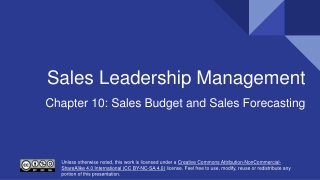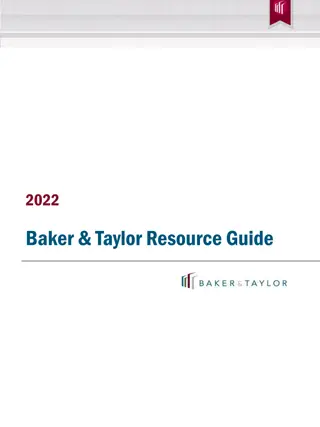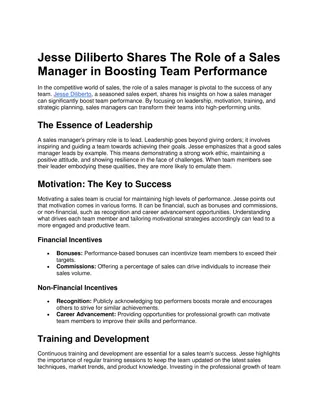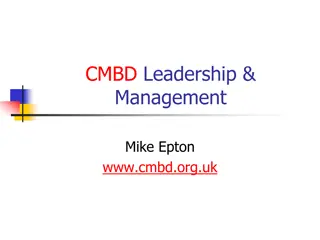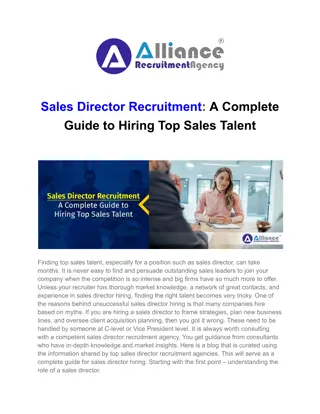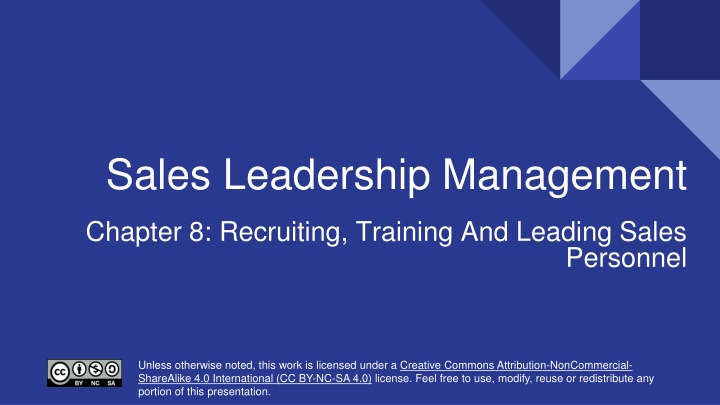
Effective Sales Team Recruitment and Training Strategies
Learn about the importance of forecasting human resource needs, effective recruitment strategies, job analysis, sources of recruitment, costs involved, onboarding importance, and various training methods for new sales personnel. Discover how trend analysis guides future staffing requirements and the significance of internal vs. external recruitment in building successful sales teams.
Download Presentation

Please find below an Image/Link to download the presentation.
The content on the website is provided AS IS for your information and personal use only. It may not be sold, licensed, or shared on other websites without obtaining consent from the author. If you encounter any issues during the download, it is possible that the publisher has removed the file from their server.
You are allowed to download the files provided on this website for personal or commercial use, subject to the condition that they are used lawfully. All files are the property of their respective owners.
The content on the website is provided AS IS for your information and personal use only. It may not be sold, licensed, or shared on other websites without obtaining consent from the author.
E N D
Presentation Transcript
Sales Leadership Management Chapter 8: Recruiting, Training And Leading Sales Personnel Creative Commons Attribution-NonCommercial-ShareAlike 4.0 International (CC BY-NC-SA 4.0) Creative Commons Attribution-NonCommercial-ShareAlike 4.0 International (CC BY-NC-SA 4.0) Unless otherwise noted, this work is licensed under a Creative Commons Attribution-NonCommercial- ShareAlike 4.0 International (CC BY-NC-SA 4.0) license. Feel free to use, modify, reuse or redistribute any portion of this presentation.
8.0 Learning Outcomes In this chapter, we will: Discuss the need for forecasting human resource needs and techniques for forecasting. Describe the impact of recruiting internal and external candidates. Explain the steps to an effective recruitment strategy. Develop a job analysis and job description. Explain the various sources of recruitment of salespeople. Outline the costs of recruitment. Discuss onboarding and its importance. Identify the different types of training available for new employees Outline ways to future proof a sales team.
8.1 Recruitment Recruitment is defined as a process that provides the organization with a pool of qualified job candidates from which to choose. It involves an element of marketing and sales, as its objective is to raise the level of interest of customers (i.e., prospective employees) in what the company has to offer (i.e., jobs). Hiring the right talent is crucial for an organization s competitive success. Staffing plan includes six main steps: Evaluate the goals of the organization. Identify the factors that might affect the staffing plan. Establish the current talent landscape. Forecasting needs. Conduct a gap analysis. Develop a recruitment plan. 1. 2. 3. 4. 5. 6.
8.1 Trend Analysis Trend analysis examines past employment levels against selected business variables to predict future staffing requirements. Forecasting is based on both internal and external factors: Internal Factors 1. Budget constraints 2. Expected or trend of employee separations 3. Production levels 4. Sales increases or decreases 5. Global expansion plans External Factors 1. Changes in technology 2. Changes in laws 3. Unemployment rates 4. Shifts in population 5. Shifts in urban, suburban, and rural areas 6. Competition Once the forecasting data are gathered and analyzed, the HR professional can see where gaps exist and then begin to recruit individuals with the right skills, education, and backgrounds.
8.2 The Recruitment Plan When devising a recruiting plan, an important element to consider is whether the pool of candidates will be internal, external, or both. Internal candidates are people who are already working for the company. If an internal candidate meets the qualifications, this person might be encouraged to apply for the job. External recruitment involves hiring candidates from outside the organization. Understanding the labor market is crucial as external factors like the pandemic can impact talent availability and create variations in specific industries. Canadian Unemployment Rates by Fanshawe College CC BY 4.0
8.2 Advantages and Disadvantages of Each Approach Recruitment Type Internal recruitment Advantages Rewards contributions of current staff Can be cost effective, as opposed to using a traditional recruitment strategy Can improve morale Knowing the past performance of the candidate can assist in knowing if they meet the criteria Disadvantages Can produce inbreeding, which may reduce diversity and different perspectives May cause political infighting between people to obtain the promotions Can create bad feelings if an internal candidate applies for a job and doesn t get it Brings new talent into the company Can help an organization obtain diversity goals New ideas and insight brought into the company Implementation of recruitment strategy can be expensive Can cause morale problems for internal candidates Can take longer for training and orientation External recruitment Table 8.2.1 Possible Advantages and Disadvantages of Hiring an Internal versus an External Candidate
8.3 Recruitment Strategy Recruitment of the right talent, at the right place and at the right time, takes skill and practice, but more importantly, it takes strategic planning. Aspects of Developing a Recruitment Strategy: Refer to a staffing plan. Confirm the job analysis is correct through questionnaires. Write the job description and job specifications. Have a bidding system to recruit and review internal candidate qualifications for possible promotions. Determine the best recruitment strategies for the position. Implement a recruiting strategy. 1. 2. 3. 4. 5. 6.
8.3 Recruitment Strategy Considerations in the recruitment process: Acknowledge the job opening and review the job description. Consider internal candidates qualifications. Choose appropriate recruiting strategies for the position. Establish a process for managing the recruitment under constraints. Ensure diversity in the applicant pool. Use job analysis and description to inform the selection process.
8.4 Job Analysis and Job Descriptions The job analysis is a formal system developed to determine what tasks people actually perform in their jobs. Job design refers to how a job can be modified or changed to be more effective. The information gathered from the job analysis is used to develop both the job description and the job specifications. A job description is a list of tasks, duties, and responsibilities of a job. Job specifications discuss the skills and abilities the person must have to perform the job. Figure 8.4.1 Process for Writing the Job Analysis by Freddy Vale CC BY-NC-SA 4.0
8.4 Job Analysis and Job Descriptions Two types of job analyses can be performed: A task-based analysis focuses on the duties of the job. A competency-based analysis focuses on the specific knowledge and abilities an employee must have to perform the job. Once you have decided if a competency-based or task-based analysis is more appropriate for the job, you can prepare to write the job analysis. After you have determined how you will conduct the analysis, a tool to conduct the analysis should be chosen (questionaries, face-to-face interviews). Then, you can organize the data, which is helpful in creating job descriptions. When the job analysis has been completed, it is time to write the job description and specifications, using the data you collected. Job descriptions should always include the following components: Job functions; Knowledge, skills, and abilities; Education and experience required; Physical requirements of the job. Once the job description has been written, obtaining approval from the hiring manager is the next step. Then the HR professional can begin to recruit for the position.
8.4 Tips to Writing a Good Job Description Be sure to include the pertinent information: Title Department Reports to Duties and responsibilities Terms of employment Qualifications needed Think of the job description as a snapshot of the job. Communicate clearly and concisely. Make sure the job description is interesting to the right candidate applying for the job. Avoid acronyms. Don t try to fit all job aspects into the job description. Proofread the job description.
8.5 Recruiting Salespeople Recruiting sales personnel consists of actively compiling a diverse pool of potential candidates which can be considered for employment. Sources of recruitment: Campus Recruiting Professional Associations Recruiters Websites Social Media Events Referrals There are three types: Executive search firm Temporary recruitmen t or staffing firm Corporate recruiter Colleges and universities can be excellent sources of new candidates They are usually non- profit organization s whose goal is to further a particular profession Your own company website Indeed.com Monster CareerBuild er Workopolis Free sites such as Craigslist, Kijiji Facebook, Twitter, LinkedIn, and YouTube are excellent places to obtain a media presence to attract a variety of workers Job fairs Conferences Other events Employee referral programs
8.5 Advantages and Disadvantages of Recruiting Methods Recruitment Method Advantages Disadvantages Can be time saving Expensive Less control over final candidates to be interviewed Time consuming Only appropriate for certain types of experience levels May be a fee to place an ad May be time-consuming to network Could be too broad Be prepared to deal with hundreds of r sum s Time consuming Overwhelming response Can be expensive May not be the right target market Research required for specific SIGS tied to jobs Outside recruiters, executive search firms, and temporary employment agencies Campus recruiting/educational institutions Professional organizations and associations Websites/Internet recruiting Can hire people to grow with the organization Plentiful source of talent Industry specific Networking Diversity friendly Low cost Quick Inexpensive Social media Access to specific target markets of candidates Industry specific Events SIG
8.5 Advantages and Disadvantages of Recruiting Methods Recruitment Method Advantages Disadvantages Higher quality people Retention Concern for lack of diversity Nepotism Referrals Inexpensive, especially with time-saving keyword r sum search software Time consuming Unsolicited r sum s and applications Can target a specific audience Can be expensive Internet and/or traditional advertisements For smaller organizations, it means someone does not have to administer compensation and benefits, as this is handled by leasing company Can be a good alternative to temporary employment if the job is permanent Possible costs Less control of who interviews for the position Employee leasing The potential ability to recruit a more diverse workforce No cost, since it s a government agency 2,300 points of service nationwide May receive many r sum s, which can be time-consuming Public employment agencies Access to specialized skills May not apply to some jobs or industries Builds relationship with the union Labour unions
8.6 Costs of Recruitment Part of recruitment planning includes budgeting the cost of finding applicants. Here is how you can calculate the cost of recruitment for the month: cost per hire = advertising costs + recruiter costs + referral costs + social media costs + event costs. A yield ratio is the percentage of applicants from one source who make it to the next stage in the selection process. The yield ratio metric helps determine how effective our recruiting methods are and aids in identifying the most effective sources for specific positions. There are five ways of hiring high-impact sales professionals: Asking the right questions: Who is a successful salesperson for you? Clarity on defining the job role backed by skill analysis Using psychometric assessments to test talent potential Investing in the right assessment tools unique to your sales strategy Combining assessment scores with structured interviews 1. 2. 3. 4. 5.
8.7 Onboarding, Orienting and Training a New Employee Any effective company has training in place to make sure employees can perform his or her job. Lack of training leads to dissatisfaction, high turnover, and costs. Four steps of effective employee training: Onboarding and orientation. In-house job-specific training. Mentorship assignment. External training. Employee training and development is the process of helping employees develop their personal and organization skills, knowledge, and abilities. Employee orientation and onboarding is the process used for welcoming a new employee into the organization, assimilating them into the culture and getting them the tools they need to start the job.
8.7 Getting Started with the Onboarding Process The process of onboarding new employees can be one of the most critical factors in ensuring recently hired talent will be productive, contented workers. Steps in Onboarding Process: Tour: Introduce company and staff to new employees. Have clear goals and expectations: Align new employees with company objectives. Create a schedule: Outline daily orientation activities and materials. Use digital documents: Minimize paperwork, provide digital documents. Match new employees with a coach or mentor: Working with a coach or mentor in a real life experience integrates the learning. After onboarding training: Organize informal events, address challenges, track progress.
8.8 Need for Training Appropriate training systems can greatly benefit the company. Sales personnel will need different types of specialized training depending on the industry and the company s unique circumstances. To determine the training system, a training needs assessment is conducted. It ought to be a systematic and objective analysis of the training needs in three main areas: organizational, job, and person. Training methods: In-House Training: This programs are learning opportunities developed by the organization in which they are used. Mentoring: A mentor may be a supervisor, but often a mentor is a colleague who has the experience and personality to help guide someone through processes External Training: Includes any type of training that is not performed in-house.
8.9 Future Proof Your Sales Teams The digital age and emerging technologies are changing business operations and growth strategies. New technologies like artificial intelligence (AI), natural language processing, machine learning, virtual reality, and automation solutions such as chatbots are applied in sales. Upskilling sales teams is necessary. This will ensure that they are equipped to adapt to market upheavals and technological advancements. Use of AI-powered database systems, data analytics, and smart CRM tools are making quicker sales. It is crucial to choose the right training design and program. IDEA (Induct, Develop, Enable, Assess) is an approach for sustained workforce development in the face of technology disruption, diversity of the company s operations, or even manpower churn. Focus on continuous training to adapt to changing market trends and requirements. Soft skills and personal customer conversations remain crucial in technology-driven age. Integrated efforts between education, government functionaries, industry experts, and leading researchers around the globe are needed to prepare and generate 'industry-ready' and future-ready salespeople. Training and upskilling are imperative for sustained success.

